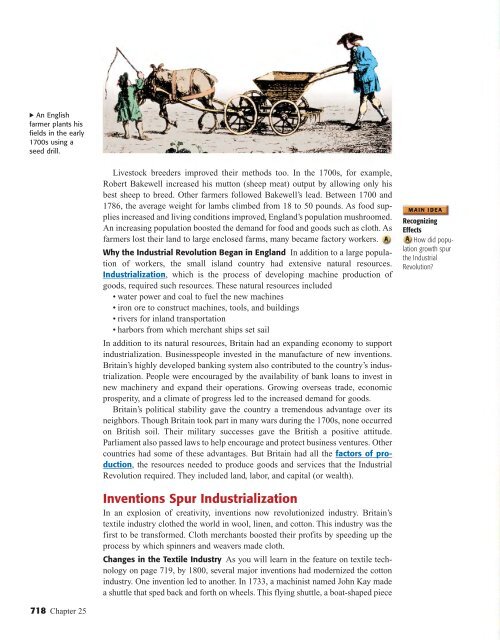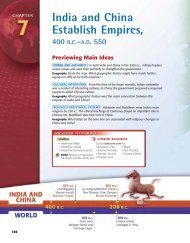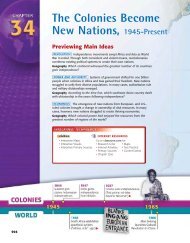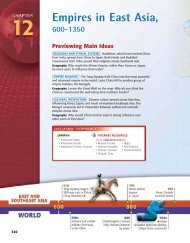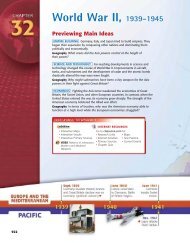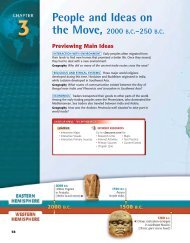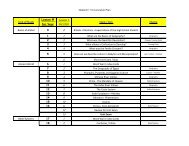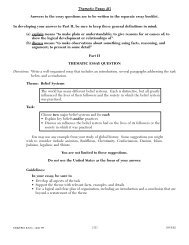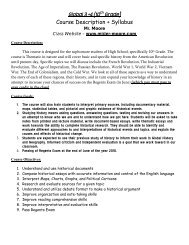The Industrial Revolution, 1700– 1900 Previewing Main Ideas
The Industrial Revolution, 1700– 1900 Previewing Main Ideas
The Industrial Revolution, 1700– 1900 Previewing Main Ideas
Create successful ePaper yourself
Turn your PDF publications into a flip-book with our unique Google optimized e-Paper software.
An English<br />
farmer plants his<br />
fields in the early<br />
1700s using a<br />
seed drill.<br />
▲<br />
718 Chapter 25<br />
Livestock breeders improved their methods too. In the 1700s, for example,<br />
Robert Bakewell increased his mutton (sheep meat) output by allowing only his<br />
best sheep to breed. Other farmers followed Bakewell’s lead. Between 1700 and<br />
1786, the average weight for lambs climbed from 18 to 50 pounds. As food supplies<br />
increased and living conditions improved, England’s population mushroomed.<br />
An increasing population boosted the demand for food and goods such as cloth. As<br />
farmers lost their land to large enclosed farms, many became factory workers.<br />
Why the <strong>Industrial</strong> <strong>Revolution</strong> Began in England In addition to a large population<br />
of workers, the small island country had extensive natural resources.<br />
<strong>Industrial</strong>ization, which is the process of developing machine production of<br />
goods, required such resources. <strong>The</strong>se natural resources included<br />
• water power and coal to fuel the new machines<br />
• iron ore to construct machines, tools, and buildings<br />
• rivers for inland transportation<br />
• harbors from which merchant ships set sail<br />
In addition to its natural resources, Britain had an expanding economy to support<br />
industrialization. Businesspeople invested in the manufacture of new inventions.<br />
Britain’s highly developed banking system also contributed to the country’s industrialization.<br />
People were encouraged by the availability of bank loans to invest in<br />
new machinery and expand their operations. Growing overseas trade, economic<br />
prosperity, and a climate of progress led to the increased demand for goods.<br />
Britain’s political stability gave the country a tremendous advantage over its<br />
neighbors. Though Britain took part in many wars during the 1700s, none occurred<br />
on British soil. <strong>The</strong>ir military successes gave the British a positive attitude.<br />
Parliament also passed laws to help encourage and protect business ventures. Other<br />
countries had some of these advantages. But Britain had all the factors of production,<br />
the resources needed to produce goods and services that the <strong>Industrial</strong><br />
<strong>Revolution</strong> required. <strong>The</strong>y included land, labor, and capital (or wealth).<br />
Inventions Spur <strong>Industrial</strong>ization<br />
In an explosion of creativity, inventions now revolutionized industry. Britain’s<br />
textile industry clothed the world in wool, linen, and cotton. This industry was the<br />
first to be transformed. Cloth merchants boosted their profits by speeding up the<br />
process by which spinners and weavers made cloth.<br />
Changes in the Textile Industry As you will learn in the feature on textile technology<br />
on page 719, by 1800, several major inventions had modernized the cotton<br />
industry. One invention led to another. In 1733, a machinist named John Kay made<br />
a shuttle that sped back and forth on wheels. This flying shuttle, a boat-shaped piece<br />
Recognizing<br />
Effects<br />
How did population<br />
growth spur<br />
the <strong>Industrial</strong><br />
<strong>Revolution</strong>?


